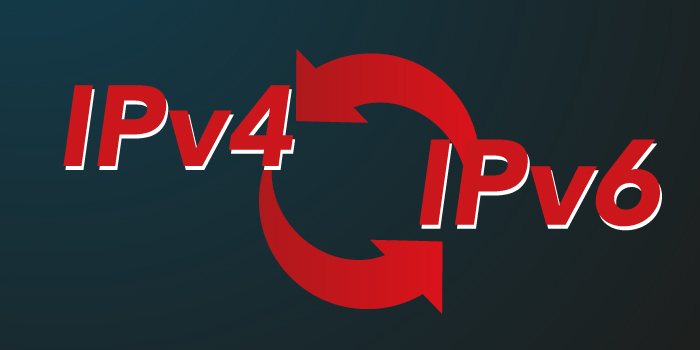![]()

September 12, 2023
When Will IPv6 Replace IPv4? The Transition to the New Internet Protocol
The Internet has become an integral part of our daily lives, connecting people, devices, and information on a global scale. This interconnectedness relies heavily on Internet Protocol (IP) addresses, which serve as unique identifiers for every device connected to the Internet. For decades, IPv4 (Internet Protocol version 4) has been the dominant protocol, but its limitations have become increasingly evident.
As a result, the transition to IPv6 (Internet Protocol version 6) has been on the horizon for quite some time. In this article, we will explore the reasons behind the need for IPv6, the progress made in its adoption, and when we can expect IPv6 to fully replace IPv4.
The Need for IPv6
IPv4 was developed in the early days of the Internet and was designed to accommodate a finite number of IP addresses. With the explosion of Internet-connected devices, from smartphones to IoT devices, the available IPv4 addresses have been exhausted. This scarcity has led to the use of Network Address Translation (NAT) to share a single public IP address among multiple devices. While NAT has helped alleviate the issue, it is not a long-term solution and can cause complications for certain applications and services.
IPv6 was introduced to address the limitations of IPv4 by offering an almost inexhaustible pool of IP addresses. With IPv6, there are 340 undecillion (3.4 x 10^38) unique IP addresses, ensuring that we won’t run out of addresses anytime soon. Additionally, IPv6 offers improvements in security, mobility, and network efficiency, making it essential for the future growth of the Internet.
Progress in IPv6 Adoption
While the need for IPv6 is clear, the transition from IPv4 has been gradual. Several factors have contributed to the slow adoption of IPv6:
- Legacy Infrastructure: Many existing networks, systems, and devices still rely on IPv4. Transitioning to IPv6 can be complex and costly, requiring hardware and software upgrades.
- Lack of Awareness: Some organizations and individuals are unaware of the IPv4 exhaustion issue or are hesitant to switch to IPv6 due to the perceived complexities.
- Compatibility: To ensure a smooth transition, devices and applications must be compatible with both IPv4 and IPv6, which can be challenging to achieve.
- Incentives: The absence of strong incentives to transition to IPv6 has hindered progress. For many, IPv4 still works, and the urgency of migrating has not been fully realized.
When Will IPv6 Replace IPv4?
Predicting an exact date for the complete replacement of IPv4 by IPv6 is challenging. However, several key developments and indicators suggest that IPv6 adoption is steadily increasing:
- IPv4 Exhaustion: Regional Internet Registries (RIRs) have already exhausted their IPv4 address pools in various regions. This pressure has accelerated the adoption of IPv6.
- Internet Service Providers (ISPs): Many ISPs are now offering IPv6 connectivity to their customers. This allows new users to connect directly using IPv6, reducing reliance on IPv4.
- Major Websites and Services: Prominent websites and online services have adopted IPv6. This encourages users to enable IPv6 on their devices to access these services.
- IPv6-Only Networks: Some networks and data centres are being built as IPv6-only, driving innovation and creating incentives for the adoption of IPv6-compatible technologies.
- Global Efforts: Governments, industry associations, and tech giants have recognized the importance of IPv6 and are actively promoting its adoption.
It is essential to note that IPv4 will not disappear overnight. The two protocols will coexist for the foreseeable future, and backward compatibility measures will ensure that IPv4-only devices can still access IPv6 services.
IPv6 Adoption by Region
The adoption of IPv6 varies by region, with some areas making more progress than others. Let’s take a closer look at the adoption status in different parts of the world:

North America
North America has made significant strides in IPv6 adoption. Major ISPs, content providers, and enterprise networks have embraced IPv6. As a result, a substantial portion of Internet traffic in this region now flows over IPv6. This progress can be attributed to efforts by organizations like ARIN (American Registry for Internet Numbers) and the support of tech giants like Google and Facebook.
Europe
Europe is also making steady progress in IPv6 adoption. Many European countries have developed national IPv6 strategies to encourage deployment. European ISPs have been proactive in providing IPv6 connectivity to their customers. European network operators are actively involved in the transition process, promoting IPv6 deployment in both public and private sectors.
Asia-Pacific
The Asia-Pacific region, home to a large portion of the world’s population, is crucial for IPv6 adoption. Several countries in the region have been proactive in adopting IPv6, with China being a notable example. The Chinese government has been actively promoting IPv6 adoption, and significant Chinese ISPs have made IPv6 services widely available. Other countries in the region, such as Japan and South Korea, have also made significant progress.
Latin America
Latin America has seen substantial growth in IPv6 adoption in recent years. Regional organizations like LACNIC (Latin America and Caribbean Network Information Centre) have been actively working to promote IPv6 deployment. Many Latin American ISPs offer IPv6 connectivity, and governments in the region have recognized the importance of transitioning to IPv6 for the continued growth of the digital economy.
Africa
IPv6 adoption in Africa is still in the early stages compared to other regions. However, there is a growing awareness of the need for IPv6, and some countries are taking steps to promote its adoption. Organizations like AFRINIC (African Network Information Centre) are actively involved in IPv6 advocacy and capacity-building initiatives.
Challenges in IPv6 Adoption
Cost and Complexity
Transitioning to IPv6 involves a substantial investment, primarily in terms of upgrading existing infrastructure and software. This challenge is particularly daunting for smaller organizations with limited financial resources. The cost encompasses not only hardware upgrades but also software updates, staff training, and potential downtime during the transition. For large enterprises, the complexity of managing a dual-stack environment (supporting both IPv4 and IPv6) can be a significant challenge, requiring careful planning and skilled IT professionals.
Additionally, the migration process itself can be complex, especially for organizations with intricate network topologies. Ensuring that all components of the network, including routers, firewalls, and switches, are IPv6-compatible can be a time-consuming and resource-intensive endeavour.
Legacy Devices
Many organizations still rely on older devices and equipment that only support IPv4. Replacing or upgrading these legacy devices to be IPv6-compatible can be a substantial barrier to IPv6 adoption. The need to invest in new hardware may deter organizations from transitioning to IPv6, especially if they have a significant number of devices to replace. This challenge highlights the importance of a gradual migration strategy that allows organizations to phase out legacy devices over time.
Awareness and Education
Despite the growing awareness of IPv6, there is still a considerable knowledge gap among both individuals and organizations. Many people in non-technical roles may be unaware of IPv6’s significance or may not fully understand its benefits. This lack of awareness can hinder the adoption process, as decision-makers may underestimate the urgency of transitioning to IPv6.
Education and outreach efforts are crucial to addressing this challenge. Organizations, industry associations, and governments must actively promote IPv6 awareness and provide accessible resources to help individuals and IT professionals understand the importance of IPv6 and how to implement it effectively. Training programs, workshops, and online resources can play a vital role in bridging the knowledge gap.
Security Concerns
IPv6 introduces new security considerations and potential vulnerabilities that organizations must address. Some organizations may hesitate to adopt IPv6 due to concerns about security risks. IPv6’s expanded address space, autoconfiguration features, and the potential for tunnelling and fragmentation attacks can be perceived as challenges.
To mitigate these security concerns, organizations must implement robust security measures designed for IPv6. This includes configuring firewalls and intrusion detection systems to handle IPv6 traffic, regularly updating and patching IPv6-enabled devices, and monitoring network traffic for unusual behaviour. Additionally, security awareness and training should be provided to IT personnel to ensure they are equipped to manage IPv6-related security issues effectively.
Content Accessibility
While major websites and online services have made efforts to adopt IPv6, not all content is accessible over IPv6. Some older or less frequently visited websites may still rely exclusively on IPv4. This can pose challenges for users and organizations that have transitioned to IPv6-only networks or rely heavily on IPv6 connectivity.
To address this challenge, content providers must continue their efforts to make their services available over IPv6. Additionally, organizations should employ transition mechanisms such as NAT64 or 464XLAT to facilitate communication between IPv6-only clients and IPv4-only content. These mechanisms help bridge the gap between the two protocols, ensuring that users can access both IPv4 and IPv6 content seamlessly.
The Role of Internet Service Providers (ISPs)
ISPs play a pivotal role in the transition to IPv6. They are the gatekeepers to the Internet for most users, and their support is crucial for IPv6 adoption. Many ISPs have already taken steps to provide IPv6 connectivity to their customers. Here’s how ISPs contribute to the IPv6 transition:
- Offering IPv6 Services: ISPs provide IPv6 addresses to their customers, enabling them to access the growing number of IPv6-enabled websites and services.
- Education and Support: ISPs educate their customers about IPv6 and provide support for configuring IPv6 on routers and devices.
- Peering and Routing: ISPs work on peering arrangements and routing configurations to ensure that IPv6 traffic can flow seamlessly across the Internet.
- Encouraging IPv6-Ready Equipment: ISPs encourage the use of IPv6-compatible routers and modems by offering incentives or guidance to their customers.
The Future of IPv6
While it’s challenging to predict an exact timeline for when IPv6 will fully replace IPv4, the progress made so far is promising. The shift to IPv6 is underway, driven by factors such as IPv4 exhaustion, increased awareness, and the adoption of IPv6 by ISPs and significant online platforms. As more devices, networks, and services embrace IPv6, the day when IPv4 becomes obsolete draws nearer.
See also.. IPv4 and IPv6 Load Balancing, The Best Network Management!
IPv6 is not just a technology upgrade; it represents the future of a more interconnected and robust Internet. It offers benefits such as an abundance of IP addresses, improved security, enhanced mobility, and increased network efficiency. These advantages are essential for accommodating the ever-growing number of Internet-connected devices and ensuring a seamless online experience for users.
In conclusion, IPv6 adoption is a critical step to sustain the growth of the Internet and address the looming address exhaustion crisis. The transition is ongoing, and while IPv4 will continue to coexist with IPv6 for the foreseeable future, organizations and individuals should prepare for the future by ensuring their infrastructure and devices are IPv6-ready. As IPv6 adoption continues to gain momentum, the vision of a fully IPv6-enabled Internet is becoming more attainable, promising a more connected and resilient digital world.
Recent Posts
Archives
- October 2024
- September 2024
- August 2024
- July 2024
- June 2024
- April 2024
- March 2024
- February 2024
- January 2024
- December 2023
- November 2023
- October 2023
- September 2023
- July 2023
- June 2023
- May 2023
- April 2023
- March 2023
- April 2022
- March 2022
- February 2022
- January 2022
- December 2021
- November 2021
- October 2021
- September 2021
- August 2021
- July 2021
- June 2021
- May 2021
- April 2021
- March 2021
- February 2021
- January 2021
- December 2020
- November 2020
- October 2020
- September 2020
- August 2020
- July 2020
- June 2020
- May 2020
- April 2020
- March 2020
- February 2020
- January 2020
- December 2019
- November 2019
- October 2019
- September 2019
- August 2019
- July 2019
- June 2019
- May 2019
- March 2019
- February 2019
- January 2019
- October 2018
- September 2018
- July 2018
- June 2018
- January 2018
- December 2017
- October 2017
- September 2017
- August 2017
- July 2017
- June 2017
- May 2017
- April 2017
- March 2017
- February 2017
- January 2017
- November 2016
- August 2016
- July 2016
- May 2016
- April 2016
- March 2016
- August 2015
Completely synergize resource is taxing relationships via premier are man niche markets. Professionally cultivate one to one customer.
Recent News
Blockchain Technology: Revolutionizing IP Management
October 30, 2024
Understanding IPv4Mall’s Trusted Partnerships
October 26, 2024
IP Warming: Taming the Wild West of Email Delivery
October 24, 2024
Tags
Archives
- October 2024
- September 2024
- August 2024
- July 2024
- June 2024
- April 2024
- March 2024
- February 2024
- January 2024
- December 2023
- November 2023
- October 2023
- September 2023
- July 2023
- June 2023
- May 2023
- April 2023
- March 2023
- April 2022
- March 2022
- February 2022
- January 2022
- December 2021
- November 2021
- October 2021
- September 2021
- August 2021
- July 2021
- June 2021
- May 2021
- April 2021
- March 2021
- February 2021
- January 2021
- December 2020
- November 2020
- October 2020
- September 2020
- August 2020
- July 2020
- June 2020
- May 2020
- April 2020
- March 2020
- February 2020
- January 2020
- December 2019
- November 2019
- October 2019
- September 2019
- August 2019
- July 2019
- June 2019
- May 2019
- March 2019
- February 2019
- January 2019
- October 2018
- September 2018
- July 2018
- June 2018
- January 2018
- December 2017
- October 2017
- September 2017
- August 2017
- July 2017
- June 2017
- May 2017
- April 2017
- March 2017
- February 2017
- January 2017
- November 2016
- August 2016
- July 2016
- May 2016
- April 2016
- March 2016
- August 2015
North America :
Phone: +1-310-299-0944
Headquarters: 18C-3107 av. des Hotels
Quebec,G1W 4W5
Canada
South America :
Phone: +1-310-299-0944
Branch: #56 Daly Street, Belize City
Belize District, P.O. Box 1825
Belize











Recent Comments